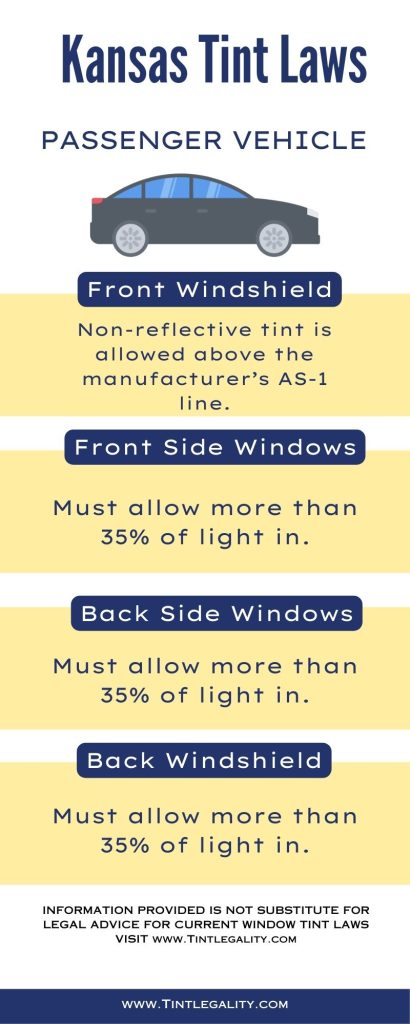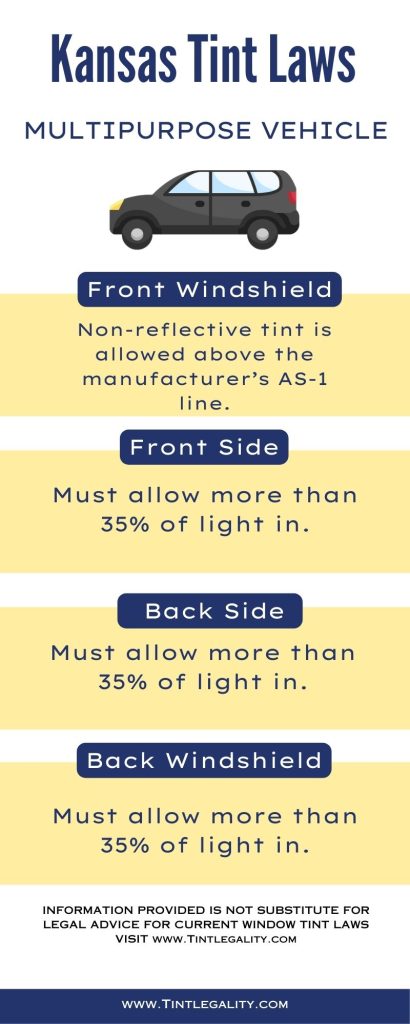Kansas Tint Laws were enacted in 1987 and have since been a crucial guideline for vehicle owners and window tinting service providers in the state.
It’s important to be aware of these rules to avoid potential legal issues while enjoying the benefits of window tinting.
Regulations Regarding Window Tint in Kansas
Understandably, there are specific regulations about the darkness and reflection of the tint. Here’s how these rules break down for different parts of the vehicle:
| Part of Vehicle | Light Allowance |
|---|---|
| Windshield | Non-reflective tint along the top of the windshield above the manufacturer’s AS-1 line |
| Front Side Windows | More than 35% light in |
| Back Side Windows | More than 35% light in |
| Rear Window | More than 35% light in |
Windshield
Kansas laws allow non-reflective tint along the top of the windshield above the manufacturer’s AS-1 line.
This maintains visibility for the driver, while also providing some sun-blocking benefits.
Front Side Windows
For front side windows, the laws state that the window tint must allow more than 35% of light into the vehicle.
This is a fair balance that offers privacy, glare reduction, and heat blocking while ensuring that you have clear visibility.
Back Side Windows
Kansas Tint Laws also require that back-side windows allow more than 35% of light in.
This requirement is consistent across different vehicle types, including sedans and SUVs.
Rear Window
The rear window, too, must allow more than 35% light in.
This means that for all windows in your vehicle, you will need to make sure the tinting film you choose meets this guideline.


Additional Regulations
Additional regulations regarding window tinting in Kansas are in place to ensure safety and compliance.
These include restrictions on the color of tint you can use, requirements for dual side mirrors if your back window is tinted, and stipulations about certification and stickers.
Reflection
Kansas law states that window tints can reflect incoming light to reduce glare and heat.
But remember, it should not have a metallic or mirrored appearance.
Medical Exemptions
Interestingly, Kansas law allows medical exemptions for window tint.
So, if you have a medical condition that requires a darker tint, you may be eligible for an exemption.
Be sure to consult with a legal expert to understand how you can apply for this.
Color Restrictions
It’s worth noting that there are color restrictions in place. The law explicitly states that RED, AMBER, and YELLOW colors are not allowed for window tints.
Side Mirrors
In Kansas, dual-side mirrors are required if the back window is tinted.
This ensures that drivers have adequate visibility when changing lanes or reversing, even with the rear window tinted.
Exceptions to Legal Limits
Apart from medical exemptions, the laws are generally firm with few exceptions.
Always remember to double-check the information with your local DMV or law enforcement authorities as interpretations may vary slightly from county to county.
Penalties for Breaking the Law
| Conviction | Penalty |
|---|---|
| First Conviction | Fine, possible requirement to remove non-compliant tint |
| Second Conviction | Higher fine, possible impact on insurance premiums, potential suspension of driving privileges |
| Third Conviction | Even higher fines, extended suspension of driver’s license, possible jail time |
Breaking window tint laws in Kansas can result in penalties. It’s a Class C misdemeanor, and penalties can vary depending on whether it’s a first, second, or third conviction.
Fines
Fines are common penalties for breaking the tint laws. While these vary, it’s important to understand that a violation can cost you not just in terms of monetary fines but also points on your driving record.
First Conviction
A first conviction typically results in a fine. You may also be asked to remove the non-compliant tint from your windows.
Second Conviction
A second conviction could carry a higher fine and may impact your insurance premiums. In some cases, a second conviction could also result in a suspension of your driving privileges.
Third Conviction
A third conviction is taken very seriously and could result in even steeper fines, extended suspension of your driver’s license, and possibly even jail time.
Other Penalties
In addition to fines and potential jail time, other penalties could include community service or being required to attend a driver’s education program.
Penalties for Non-Compliance
Non-compliance with Kansas Tint Laws can result in harsh penalties, so it’s in your best interest to ensure your vehicle’s window tint meets the state’s legal standards.
While the benefits of tinting are plentiful, it’s essential to enjoy them responsibly and lawfully.
In summary, understanding Kansas Tint Laws can go a long way in ensuring you remain compliant while enjoying the benefits of window tint.
Consult with professionals, and always ensure your tint meets the legally accepted standards.
FAQs
Can you have tinted windows in Kansas?
Yes, you can have tinted windows in Kansas, but specific regulations apply.
Can you get a tint exemption in Kansas?
Tint exemptions may be available.
Is 20% tint legal in Kansas?
20% tint is not legal.
What’s the darkest legal tint?
The darkest legal tint varies by state.
How dark is 35 tint on the windshield?
35% tint on the windshield is moderately dark.
References: